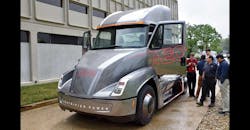Cummins says it’s ready to produce the truck powertrain of the future
EVEN with its centennial celebration upcoming, Cummins Inc executives are focused on the next 100 years, as company leadership detailed in a series of presentations at an August 29 press event in Columbus, Indiana. The conference, dubbed “Now It All Changes,” culminated in the unveiling of the AEOS, a Class 7 tractor with full battery electric power.
Indeed, as a company that’s been in business for a century, Cummins has seen market disruptions come and go—and it has responded to each challenge, suggested Srikanth Padmanabhan, head of the engine business. In his briefing ahead of the AOES unveiling, he ticked off a series of changes he’s participated in during his 27-year career at Cummins, including positions in five different divisions: In the early 1990s, he saw the move from mechanical engines to electronic controls; in the early 2000s, Cummins “caught the wave” of globalization in the power generation business; then the industry went through nearly 10 years of “emissions disruption” with the evolution of diesel aftertreatment systems.
“It feels to me that I’ve been in the right place at the right time with this company,” Padmanabhan said. “We succeeded in these disruptions because Cummins is a technology company that embraces change, and capitalizes on change with the right technology that matters.”
Looking to the coming 15 years, Padmanabhan anticipates disruption in three main areas: energy, connectivity, and automation. And again, Cummins is “uniquely positioned to take advantage” of these disruptions, he continued, “and win the marketplace for our customers.”
Internal combustion
While internal combustion engines will remain the best solution for some applications, they will be powered by a variety of fuels. More significantly, future internal combustion engines will feature some form of electrification: whether “mild hybrid” or “range extender” electric powertrains, Padmanabhan explained. But increasingly, especially for urban or short-haul applications, battery electric and fuel cell powertrains will become prevalent—and Cummins will have solutions.
“We will be the powertrain provider of choice for our customers, regardless of what the powertrain choice is,” he said. “Connectivity and electrification disruptions are here, and we will capitalize on those disruptions much as we capitalized on other disruptions over the last few decades.”
The subsequent unveiling of the AEOS provided a preview of that future. The zero-emissions, 4x2 day cab tractor was built as a “technology demonstrator” for vocational applications such as urban delivery operations, port drayage, and terminal container handling.
“This truck is designed to demonstrate that Cummins is very serious about being the leader in electrified power and shows that we will be ready to service all our markets as and when there is real value for our customers,” said Julie Furber, executive director, electrification business for Cummins, as she presented the vehicle on the grounds of the Cummins Technical Center.
Electric tractor
As for performance, the AEOS has a range of approximately 100 miles on a single charge of its 140KWhr battery. And it’s “weight neutral” with an equivalent diesel powertrain—so it can manage a full payload for weight-sensitive customers, but can also be extended to a 200-mile range with additional battery pack for less payload sensitive applications, Furber noted. The charging is a simple plug in which can return the battery to sufficient charge in about one hour, with a target time of 20 minutes by 2020.
“The efficiency is calculated to be over 30 miles per diesel gallon equivalent and the acceleration superior to a comparable diesel-powered vehicle,” Furber said. “Cool, yes? This truck enables us to demonstrate that electrified powertrains will be viable in the regional and urban hauler market in the not too distant future, and we are working with our OEM partners on product options.”
Cummins anticipates that, initially, these products will serve the transit bus market before the company takes electrification to all of its markets and the applications “when the time is right.”
Furber pointed out that Cummins already has “significant experience” in the electrified power space, with technology projects that have included building electrified powertrain solutions for commercial applications such as pick-up and delivery trucks and transit buses. Going forward, Cummins will add capabilities around energy storage, power electronics and “apply new and different business models.”
“We are currently investing, organically, and we are looking inorganically for opportunities to hasten capability and capacity development,” Furber said.
Continued R&D
While such product diversification is certainly a key to the future, Cummins company leaders also emphasized the importance of continued research and development for the core lineup of engines.
Following up on the release of the new X15 diesel engine a year ago, the coming X12 will feature ratings of 350-475 horsepower and 1250-1700 lb-ft of torque and will target regional haulers, vocational fleets and others where lower weight and optimal efficiency often are important. A tour of the Technical Center also offered journalists a sneak peek at a next-generation X15, whose development was already well underway before the current model was even on the market.
Cummins also will continue market its compressed natural gas engines though its Cummins-Westport joint venture, with ongoing R&D toward a “near-zero emissions” natural gas engine.
The facility tour included a close look at ignition and alternative fuel technology, specifically the spark-ignited ETHOS engine, an example of the company’s capability to integrate its technologies, such as fuel systems, turbos, variable valvetrain technology, and mild electrification including stop/start.
“As a global power leader for the commercial and industrial customers we serve, with an unmatched service and support network, we are better positioned than any other company to win in new and emerging technologies and in new markets,” said Rich Freeland, Cummins president and chief operating officer. “We will leverage our deep industry and customer knowledge and our scale advantage to win. Over the past century, our ability to innovate and adapt has fueled our success and we are confident we are on the right path to do it again.”
